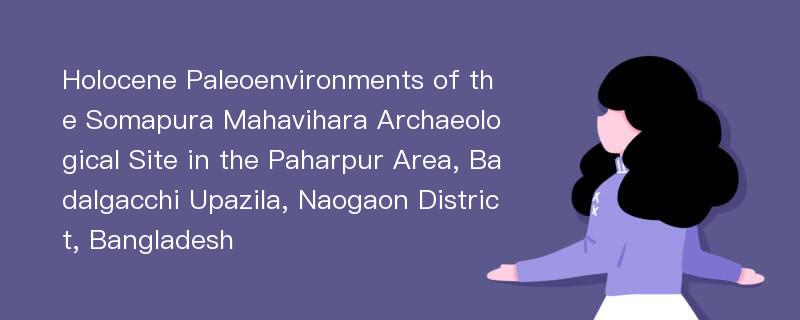
论文摘要
The World Heritage listed Somapura Mahavihara site at Paharpur represents one of the most important medieval Buddhist monuments in Asia and the largest ancient monastery yet to be discovered in Bangladesh.However,neither geoarchaeological, archaeobotanical or paleoenvironmental investigations had ever been conducted at this site.This thesis is a pioneering paleoenvironmental study using a multi-proxy approach involving clay minerals,lipids,phytolith and carbon isotope records recovered from the Holocene aged archaeological soils of the Somapura Mahavihara site located in Badalgacchi Upazila of Naogaon District,Bangladesh.Clay mineralogical data show that the dominant clay mineral is illite with subordinate amounts of kaolinite and chlorite.The high illite and low kaolinite content implies a marine or estuarine deposit.The presence of illite,together with quartz and feldspar,suggests high detrital input under generally cool to temperate and dry climates.Chlorite is another common by-product of weathering reactions with low hydrolysis,which is typical for cool to temperate and dry climates.The results suggest the existence of a marine—estuarine influence under a generally cool to temperate and dry conditions.The phytolith assemblages indicate five climate zones marked by alternatively cool and temperate events.Zones 1,3 and 5 are clearly characterized by a higher proportion of Pooideae phytoliths.The climate indices for these zones are all greater than 50,indicating cool climatic conditions.In contrast the phytolith assemblages of Zones 2 and 4 are typified by a higher proportion of Panicoideae phytoliths;their climate indices are 42 and 44,respectively,indicating the presence of a more temperate climate.In general,the dominance of grasses over broad leaved trees throughout the sequences suggests generally cool to temperate and dry conditions with some cyclical variability.Carbon isotope(δ13C)results showing a pattern of general transition from more negative values -35‰to -34.5‰at the base to less negative values -28.4‰to -27.3‰at the soil surface,all of which fall in the scope ofδ13C values for C3 plants. The isotopic values suggest a predominance of C3 plants throughout the Pala dynasty at the site,reflecting generally cool climate.The highestδ13C values occur at the 77 cm depth and at the surface soil,possibly related to a climate shift from C3- dominated cooler to drier conditions.The question of whether these climate shifts might be linked with vegetation shift from exclusively C3 to mixed C3 and C4 plants remains to be further confirmed.The hydrocarbon fractions show a dominance of n-alkanes range from n-C16to n-C33 with Cmaxat n-C18and n-C31or n-C33in a bimodal distribution with distinct odd-over-even carbon predominance observed above C22throughout the profile.Nearly consistent high CPI values(≥2)with a shift towards decreasing CPI value of 1.8 and a high Pr/n-C17and Ph/n-C18ratios at 77.5 cm depth implies that generally cool to warm conditions persisted around Paharpur and the surrounding region.Collectively the results derived from clay minerals,lipids,phytolith and carbon isotope analyses imply that generally cool to temperate and dry conditions persisted around Paharpur and the surrounding region throughout the Pala Dynasty when the site was occupied from 730 to 1080 AD with minor fluctuations through warmer and cooler periods.The emerging climatic data is consistent with the global palaeo-temperature curve during this period.The question of whether these shifts in vegetation might be linked with ENSO events is raised.
